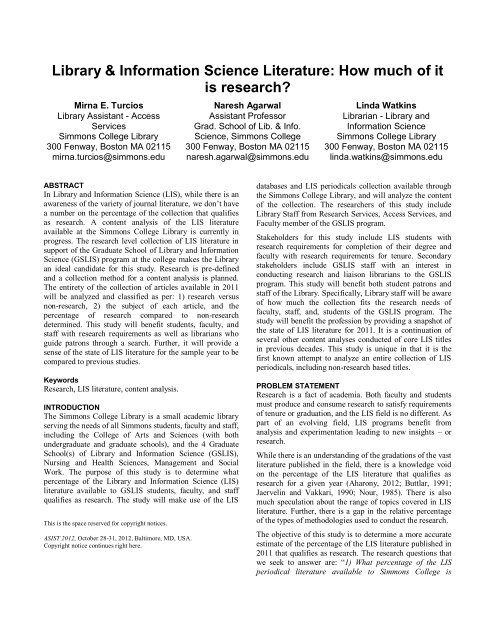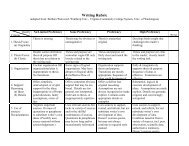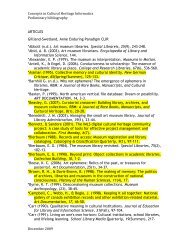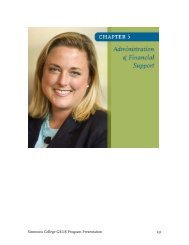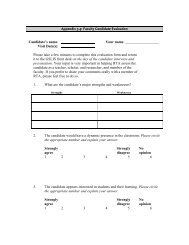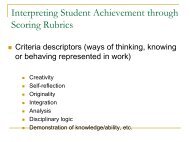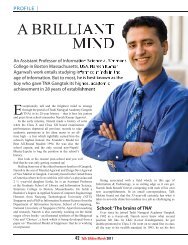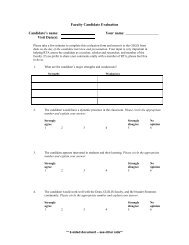SIGCHI Conference Paper Format - Graduate School of Library and ...
SIGCHI Conference Paper Format - Graduate School of Library and ...
SIGCHI Conference Paper Format - Graduate School of Library and ...
You also want an ePaper? Increase the reach of your titles
YUMPU automatically turns print PDFs into web optimized ePapers that Google loves.
<strong>Library</strong> & Information Science Literature: How much <strong>of</strong> it<br />
is research?<br />
Mirna E. Turcios<br />
<strong>Library</strong> Assistant - Access<br />
Services<br />
Simmons College <strong>Library</strong><br />
300 Fenway, Boston MA 02115<br />
mirna.turcios@simmons.edu<br />
Naresh Agarwal<br />
Assistant Pr<strong>of</strong>essor<br />
Grad. <strong>School</strong> <strong>of</strong> Lib. & Info.<br />
Science, Simmons College<br />
300 Fenway, Boston MA 02115<br />
naresh.agarwal@simmons.edu<br />
Linda Watkins<br />
Librarian - <strong>Library</strong> <strong>and</strong><br />
Information Science<br />
Simmons College <strong>Library</strong><br />
300 Fenway, Boston MA 02115<br />
linda.watkins@simmons.edu<br />
ABSTRACT<br />
In <strong>Library</strong> <strong>and</strong> Information Science (LIS), while there is an<br />
awareness <strong>of</strong> the variety <strong>of</strong> journal literature, we don’t have<br />
a number on the percentage <strong>of</strong> the collection that qualifies<br />
as research. A content analysis <strong>of</strong> the LIS literature<br />
available at the Simmons College <strong>Library</strong> is currently in<br />
progress. The research level collection <strong>of</strong> LIS literature in<br />
support <strong>of</strong> the <strong>Graduate</strong> <strong>School</strong> <strong>of</strong> <strong>Library</strong> <strong>and</strong> Information<br />
Science (GSLIS) program at the college makes the <strong>Library</strong><br />
an ideal c<strong>and</strong>idate for this study. Research is pre-defined<br />
<strong>and</strong> a collection method for a content analysis is planned.<br />
The entirety <strong>of</strong> the collection <strong>of</strong> articles available in 2011<br />
will be analyzed <strong>and</strong> classified as per: 1) research versus<br />
non-research, 2) the subject <strong>of</strong> each article, <strong>and</strong> the<br />
percentage <strong>of</strong> research compared to non-research<br />
determined. This study will benefit students, faculty, <strong>and</strong><br />
staff with research requirements as well as librarians who<br />
guide patrons through a search. Further, it will provide a<br />
sense <strong>of</strong> the state <strong>of</strong> LIS literature for the sample year to be<br />
compared to previous studies.<br />
Keywords<br />
Research, LIS literature, content analysis.<br />
INTRODUCTION<br />
The Simmons College <strong>Library</strong> is a small academic library<br />
serving the needs <strong>of</strong> all Simmons students, faculty <strong>and</strong> staff,<br />
including the College <strong>of</strong> Arts <strong>and</strong> Sciences (with both<br />
undergraduate <strong>and</strong> graduate schools), <strong>and</strong> the 4 <strong>Graduate</strong><br />
<strong>School</strong>(s) <strong>of</strong> <strong>Library</strong> <strong>and</strong> Information Science (GSLIS),<br />
Nursing <strong>and</strong> Health Sciences, Management <strong>and</strong> Social<br />
Work. The purpose <strong>of</strong> this study is to determine what<br />
percentage <strong>of</strong> the <strong>Library</strong> <strong>and</strong> Information Science (LIS)<br />
literature available to GSLIS students, faculty, <strong>and</strong> staff<br />
qualifies as research. The study will make use <strong>of</strong> the LIS<br />
This is the space reserved for copyright notices.<br />
ASIST 2012, October 28-31, 2012, Baltimore, MD, USA.<br />
Copyright notice continues right here.<br />
databases <strong>and</strong> LIS periodicals collection available through<br />
the Simmons College <strong>Library</strong>, <strong>and</strong> will analyze the content<br />
<strong>of</strong> the collection. The researchers <strong>of</strong> this study include<br />
<strong>Library</strong> Staff from Research Services, Access Services, <strong>and</strong><br />
Faculty member <strong>of</strong> the GSLIS program.<br />
Stakeholders for this study include LIS students with<br />
research requirements for completion <strong>of</strong> their degree <strong>and</strong><br />
faculty with research requirements for tenure. Secondary<br />
stakeholders include GSLIS staff with an interest in<br />
conducting research <strong>and</strong> liaison librarians to the GSLIS<br />
program. This study will benefit both student patrons <strong>and</strong><br />
staff <strong>of</strong> the <strong>Library</strong>. Specifically, <strong>Library</strong> staff will be aware<br />
<strong>of</strong> how much the collection fits the research needs <strong>of</strong><br />
faculty, staff, <strong>and</strong>, students <strong>of</strong> the GSLIS program. The<br />
study will benefit the pr<strong>of</strong>ession by providing a snapshot <strong>of</strong><br />
the state <strong>of</strong> LIS literature for 2011. It is a continuation <strong>of</strong><br />
several other content analyses conducted <strong>of</strong> core LIS titles<br />
in previous decades. This study is unique in that it is the<br />
first known attempt to analyze an entire collection <strong>of</strong> LIS<br />
periodicals, including non-research based titles.<br />
PROBLEM STATEMENT<br />
Research is a fact <strong>of</strong> academia. Both faculty <strong>and</strong> students<br />
must produce <strong>and</strong> consume research to satisfy requirements<br />
<strong>of</strong> tenure or graduation, <strong>and</strong> the LIS field is no different. As<br />
part <strong>of</strong> an evolving field, LIS programs benefit from<br />
analysis <strong>and</strong> experimentation leading to new insights – or<br />
research.<br />
While there is an underst<strong>and</strong>ing <strong>of</strong> the gradations <strong>of</strong> the vast<br />
literature published in the field, there is a knowledge void<br />
on the percentage <strong>of</strong> the LIS literature that qualifies as<br />
research for a given year (Aharony, 2012; Buttlar, 1991;<br />
Jaervelin <strong>and</strong> Vakkari, 1990; Nour, 1985). There is also<br />
much speculation about the range <strong>of</strong> topics covered in LIS<br />
literature. Further, there is a gap in the relative percentage<br />
<strong>of</strong> the types <strong>of</strong> methodologies used to conduct the research.<br />
The objective <strong>of</strong> this study is to determine a more accurate<br />
estimate <strong>of</strong> the percentage <strong>of</strong> the LIS literature published in<br />
2011 that qualifies as research. The research questions that<br />
we seek to answer are: “1) What percentage <strong>of</strong> the LIS<br />
periodical literature available to Simmons College is
esearch? 2) Of the titles that include research, what<br />
percentage <strong>of</strong> the articles in each title are research<br />
articles? 3) What is the subject distribution in both the<br />
research articles <strong>and</strong> non-research articles? 4) What<br />
methodologies are used in the research?” LIS periodicals,<br />
available both in print <strong>and</strong> online, will be collected,<br />
analyzed, <strong>and</strong> categorized. Article abstracts will be used to<br />
determine the subject <strong>and</strong> methodology <strong>of</strong> research articles.<br />
The LIS databases <strong>and</strong> periodicals stacks will be used to<br />
determine a sample size collection for this study.<br />
The findings <strong>of</strong> this study could potentially impact how LIS<br />
Librarians support LIS researchers. A better underst<strong>and</strong>ing<br />
<strong>of</strong> the percentage <strong>of</strong> available literature that is research, as<br />
opposed to non-research, could potentially lead to an<br />
improved search experience. This study will also provide a<br />
snapshot <strong>of</strong> the topics covered <strong>and</strong> methodologies used in<br />
research in 2011. Librarians <strong>and</strong> established researchers<br />
mentoring new researchers would have a more concrete<br />
sense <strong>of</strong> the amount <strong>of</strong> literature available.<br />
LITERATURE REVIEW<br />
There have been a number <strong>of</strong> content analysis papers<br />
published regarding LIS periodical <strong>and</strong> journal literature.<br />
These studies have primarily focused on the subjects<br />
covered <strong>and</strong> methodologies used in LIS research (Feehan,<br />
Havener, <strong>and</strong> Kester, 1987; Nour, 1985; Jaervelin <strong>and</strong><br />
Vakkari, 1990; Kumpulainen, 1991). While these studies<br />
provide valuable information regarding the trends <strong>of</strong><br />
research literature, they tend to focus on analyzing articles<br />
from a list <strong>of</strong> core LIS research journals. These studies<br />
intentionally exclude all non-peer reviewed <strong>and</strong> referred<br />
journals (Feehan, Gragg II, Havener <strong>and</strong> Kester, 1987;<br />
Jaervelin <strong>and</strong> Vakkari, 1993; Koufogiannakis <strong>and</strong> Slater,<br />
2004; Kumpulainen, 1991; Nour, 1985). The scope <strong>of</strong><br />
content analyses in these past studies was on a limited list<br />
<strong>of</strong> journals with a research focus. In each case, the list <strong>of</strong><br />
core journals was compiled after analyzing multiple indices<br />
to identify titles that are included in more than one database<br />
or index. Feehan et al. (1987) also solicited feedback from<br />
library pr<strong>of</strong>essionals as to their opinion <strong>of</strong> the core journals<br />
in LIS. All studies explicitly excluded international<br />
journals. Only Jaervelin <strong>and</strong> Vakkari (1990, 1993) included<br />
non-English international journals.<br />
The total list <strong>of</strong> core journals thus varied from as little as 10<br />
journals (Arahony, 2012) to 91 (Feehan et al., 1987). This<br />
indicates that there is no consistency in what qualifies as a<br />
core journal. Another factor briefly addressed by Jaervelin<br />
<strong>and</strong> Vakkari (1993) is the nature <strong>of</strong> the publishing industry.<br />
Core journal lists vary between decades because the core<br />
journals identified for one decade may cease to exist before<br />
another <strong>and</strong> new core journals may emerge since the initial<br />
year <strong>of</strong> cross-decade studies (p. 131). It is therefore<br />
generally difficult to develop an unbiased, consistent list <strong>of</strong><br />
journals that qualify as research-based or pr<strong>of</strong>essional, even<br />
when cross referencing lists <strong>of</strong> indexed titles as a means <strong>of</strong><br />
developing the core list.<br />
While part <strong>of</strong> the fluctuation can be attributed to trends in<br />
the field, it is also due in part to varying methods <strong>of</strong><br />
conducting research (Jarvelin <strong>and</strong> Vakkari, 1990). Related<br />
to this is the fact that even when only analyzing core<br />
journals, not 100% <strong>of</strong> what is published in these research<br />
journals is research (Feehan, Gragg II, Havener <strong>and</strong> Kester,<br />
1987; Buttlar, 1991; Nour, 1985; Jarvelin <strong>and</strong> Vakkari,<br />
1990; Kumpulainen, 1991).<br />
The changing lists <strong>of</strong> journal titles selected for analysis also<br />
resulted in skewed results <strong>of</strong> the percentage <strong>of</strong> research<br />
literature. Jaervelin <strong>and</strong> Vakkari found that as much as<br />
54% <strong>of</strong> their sample qualified as research while Feehan et<br />
al. (1987) found that only 23.6% <strong>of</strong> the sample qualified as<br />
research. This discrepancy makes it difficult to develop a<br />
sense <strong>of</strong> the field. An inconsistency in titles included further<br />
exacerbates the effects <strong>of</strong> a fluctuating publishing industry.<br />
The narrowest <strong>of</strong> the studies focused on a list <strong>of</strong> core<br />
journals <strong>of</strong> less than 20 each. Both Buttlar (1991) <strong>and</strong><br />
Arahony’s (2012) studies produced valuable information<br />
about trends in authorship <strong>of</strong> research in LIS literature.<br />
Buttlar (1991) analyzed author information including<br />
geographic location, sex, occupation, <strong>and</strong> geographic<br />
location. Aharony’s (2012) most recent content analysis<br />
went beyond Buttlar’s study <strong>and</strong> presented statistical<br />
descriptive analysis <strong>of</strong> research article keywords as well.<br />
Yet, the limited list <strong>of</strong> journals analyzed brings about the<br />
question <strong>of</strong> the validity <strong>of</strong> the data.<br />
A consistent theme throughout the studies is the need to<br />
define “research” before undertaking a content analysis.<br />
Several content analyses use a consistent definition <strong>of</strong><br />
research as established by Peritz (1980):<br />
Research is any inquiry which is carried out, at least to<br />
some degree, by a systematic method with the purpose <strong>of</strong><br />
[eliciting] some new facts, concepts or ideas (Feehan et al.,<br />
1987; Nour, 1985; Yontar <strong>and</strong> Yalvac, 2000).<br />
But, as Nour suggests, even a highly accepted definition is<br />
“criticized for its lack <strong>of</strong> rigor” (p. 262). This definition is<br />
<strong>of</strong>ten critiqued as being too broad <strong>and</strong> not specific enough<br />
to the field (Koufogiannakis <strong>and</strong> Slater, 2004). Still, this<br />
definition endures for its inclusion <strong>of</strong> its key concepts,<br />
“method” <strong>and</strong> “purpose,” which allow a researcher to more<br />
easily distinguish research articles from other articles<br />
(Feehan et al., 1987; Nour, 1985; Yontar <strong>and</strong> Yalvac,<br />
2000). Use <strong>of</strong> a consistent definition increases the external<br />
validity <strong>of</strong> the studies, even if their core journal lists vary<br />
drastically.<br />
This definition has also been used in content analyses <strong>of</strong><br />
international, non-English journals, further demonstrating<br />
its endurance <strong>and</strong> relevancy (Kajberg, 1996; Yontar <strong>and</strong><br />
Yalvac, 2000). Moreover, the use <strong>of</strong> the same definition<br />
ensures it will still be applicable to a collection that<br />
includes international, non-English journals, as this study<br />
proposes. These international studies also varied in scope.<br />
Like the American studies, Yontar <strong>and</strong> Yalvac (1996)
limited the journals included in the study. In fact, the study<br />
focused on only one journal. Still, this study demonstrated<br />
that a consistent definition produced reliable data with high<br />
internal validity. Conversely, Kajberg (1996) exp<strong>and</strong>ed his<br />
research to include all the Danish LIS literature published<br />
from 1957 to 1986. Unlike the American studies, the<br />
Danish studies included non-research as well as research<br />
journals, demonstrating that it is possible to compare across<br />
types <strong>of</strong> journals. These two international studies establish<br />
the validity <strong>of</strong> Peritz’s definition <strong>of</strong> research in analyzing<br />
international articles.<br />
These studies confirm the importance <strong>of</strong> analyzing the<br />
content <strong>of</strong> both research journals <strong>and</strong> trade periodicals to<br />
develop a better sense <strong>of</strong> the amount <strong>of</strong> research that exists<br />
with the body <strong>of</strong> literature. Furthermore, it has been proven<br />
that it is possible to analyze content across journal types<br />
spanning multiple years.<br />
RESEARCH DESIGN<br />
This study aims to determine how much <strong>of</strong> the literature<br />
qualifies as research. In this study, there are no casual<br />
variables that will affect the final measure, <strong>and</strong> thus no<br />
hypotheses. Based on previous content analysis studies, we<br />
operationalize research in this study as defined by Peritz<br />
(1980).<br />
This research is approached as a content analysis study <strong>of</strong><br />
articles in LIS journals. The LIS collection for the calendar<br />
year 2011 at Simmons College <strong>Library</strong> serves as the sample<br />
year. A single, most recent, year was chosen to make the<br />
study manageable. All <strong>of</strong> the available journal titles for the<br />
calendar year will be collected, classified, <strong>and</strong> analyzed. An<br />
appropriate measure has been developed to collect the data.<br />
Once the data for the selected year is compiled, it will be<br />
analyzed.<br />
A content analysis form has been developed to categorize<br />
several key elements <strong>of</strong> each article in a journal, including:<br />
• Journal title<br />
• Volume<br />
• Issue<br />
• Page numbers<br />
• Article title<br />
• Author name(s)<br />
• Objective <strong>of</strong> the study<br />
• Method(s) used in the study<br />
• Findings <strong>of</strong> the study<br />
This content analysis will focus on the entire collection <strong>of</strong><br />
LIS periodicals available at Beatley <strong>Library</strong>. The sample for<br />
the analysis includes all journals available in 2011. The<br />
content analysis will be measured using a form developed<br />
based on previous studies, with slight modifications.<br />
Procedure<br />
Before conducting the complete analysis, a comprehensive<br />
list <strong>of</strong> journal titles in the collection will be solicited from<br />
library staff. This list will be analyzed to determine which<br />
titles were available in the collection in 2011. A list <strong>of</strong> print<br />
journals has been compiled. A comparison between the<br />
compiled list <strong>and</strong> the stacks is currently underway. A list <strong>of</strong><br />
e-journals has also been collected. An analysis <strong>of</strong> the list to<br />
determine title availability in 2011 will follow.<br />
Research assistants, or readers, will be recruited once there<br />
is a complete underst<strong>and</strong>ing <strong>of</strong> the size <strong>of</strong> the collection to<br />
be analyzed. Depending on the size, up to four readers may<br />
be recruited. Readers will be given background information<br />
regarding the project <strong>and</strong> trained on elements <strong>of</strong> the form,<br />
including:<br />
• definition <strong>of</strong> research for this project<br />
• size <strong>of</strong> collection to be analyzed<br />
• complete procedure how to properly fill out the form<br />
In the case that a periodical is clearly entirely non-research,<br />
only select articles will be analyzed for content to<br />
determine if at all they quality for research. These will<br />
include 1) full length feature articles, <strong>and</strong> 2) reviews,<br />
including for a) books <strong>and</strong> b) products such as computer<br />
hardware, s<strong>of</strong>tware, furnishings, etc.<br />
All data will be collected using a st<strong>and</strong>ard form. Once the<br />
data is collected, a small sample from the literature will be<br />
r<strong>and</strong>omly selected to test for reliability. A different reader<br />
will be assigned to analyze the articles in the sample. The<br />
analyses will then be compared to determine inter-rater<br />
reliability. If necessary, some articles may be selected for<br />
re-classification.<br />
Once the data has been compiled, it will be prepared for<br />
analysis using the SPSS s<strong>of</strong>tware. The research will result<br />
in a statistical descriptive analysis <strong>of</strong> the Simmons College<br />
<strong>Library</strong> LIS journal collection for 2011.<br />
EXPECTED RESULTS<br />
This study will result in a content analysis <strong>of</strong> a research<br />
level collection <strong>of</strong> LIS serials literature. The data is<br />
expected to show the distribution <strong>of</strong> the literature, including<br />
what percent is research <strong>and</strong> non-research, <strong>and</strong> the topics<br />
covered. This 1-year analysis will provide a snapshot <strong>of</strong> the<br />
LIS literature in a particular point in time. The trending<br />
topics are expected to reflect the political climate <strong>and</strong> LIS<br />
interests around the time selected for analysis.<br />
To be more specific, the data is also expected to show that<br />
when measured against the entirety <strong>of</strong> the published<br />
literature, research is much less then the lowest percentage<br />
calculated in previous studies. It is also expected that the<br />
topics covered in the research literature will be different<br />
from that covered in the non-research literature.<br />
Strengths <strong>and</strong> limitations <strong>of</strong> the study<br />
The size <strong>and</strong> nature <strong>of</strong> the collection chosen for this content<br />
analysis are both a strength <strong>and</strong> a limitation <strong>of</strong> this<br />
particular study. Because the Simmons College <strong>Library</strong><br />
supports a graduate program in LIS that is not only a topranked<br />
<strong>and</strong> well-established, but also the sole program in
the state <strong>of</strong> Massachusetts, the collection is quite extensive.<br />
It includes all research core journals, pr<strong>of</strong>essional <strong>and</strong> trade<br />
periodicals, popular magazines, <strong>and</strong> newsletters. This<br />
provides the opportunity to develop a complete picture <strong>of</strong><br />
all the literature that is produced in the field.<br />
At the same time, this will prove to be a challenge. A<br />
content analysis <strong>of</strong> an extensive, research-level collection<br />
will be very time consuming. It will require several hours <strong>of</strong><br />
reading. Dividing up the content as a strategy to address<br />
this challenge in turn presents a new challenge. Research<br />
assistants, or readers, will all have to be trained to make<br />
sure that there is a shared, baseline underst<strong>and</strong>ing <strong>of</strong> the<br />
definition <strong>of</strong> research. In addition, an increased number <strong>of</strong><br />
readers increase the probability <strong>of</strong> inconsistent<br />
classification. It is also expected that a large research group<br />
will present challenges to the quality <strong>of</strong> the data collection<br />
<strong>and</strong> recording. The required training time to attempt to<br />
address these issues will also add to the total time to<br />
complete the study.<br />
The time span covered in the research will help address<br />
some <strong>of</strong> these challenges. It does also in turn present<br />
another potential limitation <strong>of</strong> the study. As a st<strong>and</strong>alone<br />
one year study, we are limited in the conclusions that can be<br />
stated about the trends in LIS literature. However, the<br />
results <strong>of</strong> one year’s worth <strong>of</strong> literature will provide<br />
valuable information about the percent <strong>of</strong> research <strong>and</strong><br />
topics covered. In future studies, a comparison to an<br />
analysis <strong>of</strong> a second year’s worth <strong>of</strong> the collection would<br />
add significant value to the findings. A third data set for<br />
comparison would allow the opportunity to discover larger<br />
trends in the field.<br />
Another strength <strong>of</strong> this study is its timing. This study is<br />
being proposed at a time when resources are readily<br />
available in a variety <strong>of</strong> formats. It is more feasible to<br />
analyze an entire body <strong>of</strong> literature for a given year when<br />
there is instant access to materials online when the print<br />
materials are missing.<br />
CONCLUSION AND FUTURE WORK<br />
In conclusion, this ambitious content analysis <strong>of</strong> the<br />
Simmons College <strong>Library</strong> LIS periodicals collection, while<br />
dem<strong>and</strong>ing, could provide useful information to researchers<br />
<strong>and</strong> librarians. One <strong>of</strong> the challenges in conducting research<br />
is overcoming the unknown. How much research already<br />
exists <strong>and</strong> what is it about? These questions springboard the<br />
researcher into action. Information about the nature <strong>of</strong> the<br />
literature <strong>of</strong> the field will enhance the researcher’s approach<br />
to initial inquiry. The progress <strong>of</strong> this study will be<br />
continuously recorded in a blog for use by future<br />
researchers.<br />
A possible future study could include a parallel comparison<br />
<strong>of</strong> previous years. As Feehan et al., (1987) suggest, this<br />
study could lay the foundation for replicate studies to<br />
capture a wide picture <strong>of</strong> LIS research over time. With the<br />
appropriate level <strong>of</strong> resources <strong>and</strong> support, this study could<br />
exp<strong>and</strong> to include an analysis <strong>of</strong> the collection for the years<br />
2005 <strong>and</strong> 2015. This would allow for a comparison <strong>and</strong><br />
underst<strong>and</strong>ing <strong>of</strong> the literature over an entire decade.<br />
An additional study could include a content analysis <strong>of</strong> LIS<br />
literature born digital <strong>and</strong> available only online. At the time<br />
<strong>of</strong> this writing, only one study was available that measured<br />
the quality <strong>of</strong> an online journal (Beebe, 2003). The methods<br />
developed in this content analysis could be combined with<br />
Beebe’s to develop a tool to analyze online content.<br />
ACKNOWLEDGMENTS<br />
This research was undertaken by the authors to help answer<br />
a long-pending question in the mind <strong>of</strong> the third author. The<br />
research would not have been possible without the support<br />
<strong>and</strong> encouragement <strong>of</strong> Simmons College <strong>Library</strong> staff.<br />
REFERENCES<br />
Aharony, N. (2012). <strong>Library</strong> <strong>and</strong> Information Science<br />
research areas: A content analysis <strong>of</strong> articles from the<br />
top 10 journals 2007–8. Journal Of Librarianship &<br />
Information Science, 44(1), 27-35.<br />
Buttlar, L. (1991). Analyzing the library periodical<br />
literature: Content <strong>and</strong> authorship. College & research<br />
Libraries, (52)1, 38-53.<br />
Beebe, B. (2003). A Content Analysis Of “LIBRES”:<br />
<strong>Library</strong> & Information Research Electronic Journal.<br />
Mississippi Libraries, 67(4), 101-104.<br />
Feehan, P., Havener, W., & Kester, D. (1987). <strong>Library</strong> <strong>and</strong><br />
information science research. An analysis <strong>of</strong> the 1984<br />
journal literature. <strong>Library</strong> & Information Science<br />
Research, 9(3), 173-186.<br />
Jaervelin, K., & Vakkari, P. (1990). Content analysis <strong>of</strong><br />
research articles in library <strong>and</strong> information science.<br />
<strong>Library</strong> & Information Science Research, 12(4), 395-<br />
422.<br />
Jaervelin, K., & Vakkari, P. (1993). The evolution <strong>of</strong><br />
library <strong>and</strong> information science 1965- 1985: a content<br />
analysis <strong>of</strong> journal articles. Information Processing &<br />
Management, 29(1), 129-144.<br />
Kajberg, L. (1996). A content analysis <strong>of</strong> <strong>Library</strong> &<br />
information science serial literature published in<br />
Denmark, 1957-1986. <strong>Library</strong> & Information Science<br />
Research, 18(1), 25-52.<br />
Koufogiannakis, D., & Slater, L. (2004). A content analysis<br />
<strong>of</strong> librarianship research. Journal Of Information<br />
Science, 30(3), 227-239.<br />
Kumpulainen, S. (1991). <strong>Library</strong> <strong>and</strong> information science<br />
research in 1975: content analysis <strong>of</strong> the journal<br />
articles. Libri: International Journal Of Libraries &<br />
Information Services, (4)1, 59-76.<br />
Nour, M. M. (1985). A quantitative analysis <strong>of</strong> the research<br />
articles published in core library journals <strong>of</strong> 1980.<br />
<strong>Library</strong> & Information Science Research, 7261-273.<br />
Yontar, A., & Yalvaç, M. (2000). Problems <strong>of</strong> library <strong>and</strong><br />
information science research in Turkey: a content<br />
analysis <strong>of</strong> journal articles 1952-1994. IFLA Journal,<br />
26(1), 39- 51.


